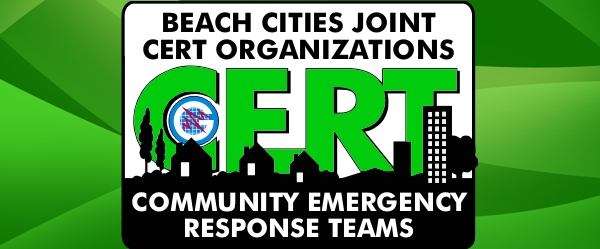
CERT Training
Each city has it's own training program. Use the Links to Our Members' Web Sites to find out when that city's next training is.
CERT training consists of the following:
- Session I, DISASTER PREPAREDNESS: address hazards to which people are vulnerable in their community. Materials cover actions that participants and their families take before, during, and after a disaster. As the session progresses, the instructor begins to explore an expanded response role for civilians in that they should begin to consider themselves Disaster Workers. Since they will want to help their family members and neighbors, this training can help them operate in a safe and appropriate manner. The CERT concept and organization are discussed as well as applicable laws governing volunteers in that jurisdiction.
- Session II, DISASTER FIRE SUPPRESSION: Briefly covers fire chemistry, hazardous materials, fire hazards, and fire suppression strategies. However, the thrust of this session is the safe use of fire extinguishers, sizing up the situation, controlling utilities and extinguishing a small fire.
- Session III, DISASTER MEDICAL OPERATIONS PART I: Participants practice diagnosing and treating airway obstruction, bleeding, and shock by using simple triage and rapid treatment techniques.
- Session IV, DISASTER MEDICAL OPERATIONS, PART II: Covers evaluating patients by doing a head to toe assessment, establishing a medical treatment area, performing basic first aid, and practicing in a safe and sanitary manner.
- Session V, LIGHT SEARCH AND RESCUE OPERATIONS: Participants learn about search and rescue planning, size-up, search techniques, rescue techniques, and most important, rescuer safety.
- Session VI, DISASTER PSYCHOLOGY AND TEAM ORGANIZATION: Covers signs and symptoms that might be experienced by the disaster victim and worker. It addresses CERT organization and management principles and the need for documentation.
- Session VII, COURSE REVIEW AND DISASTER SIMULATION: Participants review their answers from a take home examination. Finally, they practice the skills that they have learned during the previous six sessions in disaster activity.